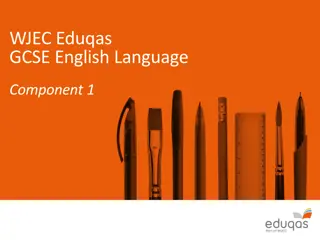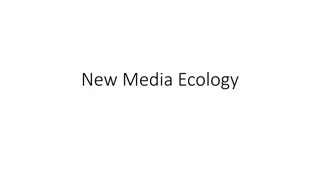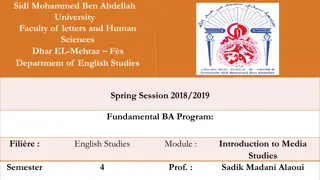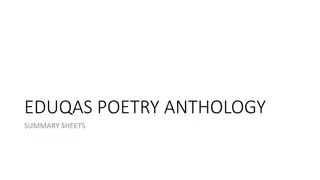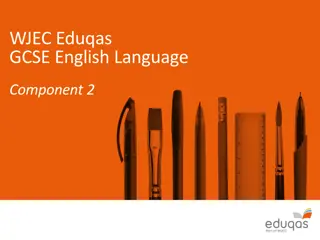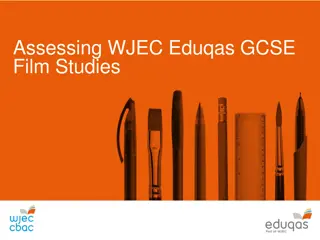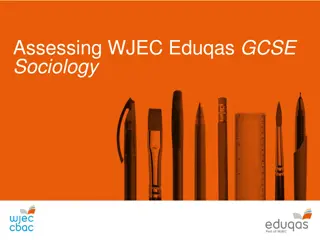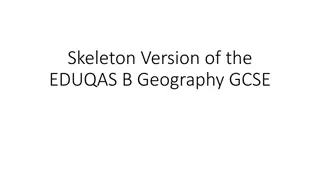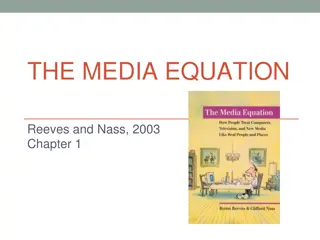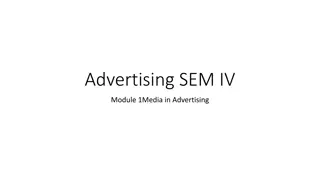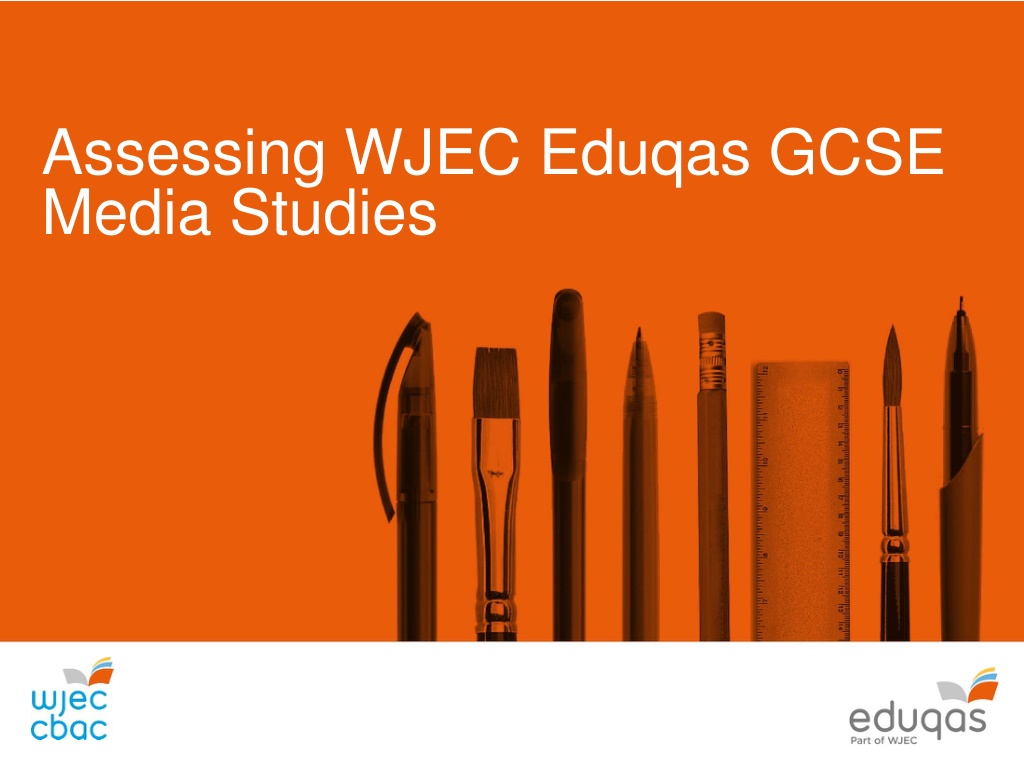
Understanding and Assessing Evidence in WJEC Eduqas GCSE Media Studies
Learn how to ensure objectivity in assessing student responses, understand assessment criteria, and exercise academic judgment through levels of response mark schemes in WJEC Eduqas GCSE Media Studies. Explore the importance of assessment purpose, formative vs. summative assessment, and center-devised assessments for accurate marking.
Download Presentation

Please find below an Image/Link to download the presentation.
The content on the website is provided AS IS for your information and personal use only. It may not be sold, licensed, or shared on other websites without obtaining consent from the author. Download presentation by click this link. If you encounter any issues during the download, it is possible that the publisher has removed the file from their server.
E N D
Presentation Transcript
Assessing WJEC Eduqas GCSE Media Studies
Assessing evidence It is important to ensure objectivity in assessing students responses, both at the initial marking stage and during internal standardisation. Do not allow personal knowledge of individual students to affect assessment decisions: ensure that you mark the student responses in front of you rather than the students behind them. JCQ has provided training on ensuring objectivity when assessing students evidence. You should also consider the purpose of the assessment, particularly if you are selecting evidence which has been completed earlier in the course. Formative assessment, conducted during the course of the learning in order to gauge student understanding, may not always provide appropriate evidence, as the student may not have fully developed their understanding of all concepts to the best of their ability at this point in time. Summative assessment, either at the end of the course or the end of a component may provide a more realistic picture of the students attainment levels.
Assessing evidence Understanding the assessment criteria Assessment criteria generally take two forms: objective marking generally for low tariff responses, where knowledge of objective information is being assessed the exercising of academic judgement via: an assessment grid setting out criteria for different levels of response indicative content, that is, an indication of the kind of content responses may include.
Assessing evidence Understanding the assessment criteria exercising academic judgement through levels of response mark schemes Firstly, identify the appropriate band a student s response falls into according to the criteria. Award a band where the student s response covers the majority of the criteria. Secondly, consider a mark in the centre of the band and then increase or decrease the mark depending on the quality of the answer, which may be reflected in the amount of indicative content covered. If a response falls between two bands, consider whether there are more characteristics of the higher or lower of the two bands and award accordingly. Indicative content is not exhaustive and other valid responses may be credited.
Assessing evidence Understanding the assessment criteria centre-devised assessments Teachers should, wherever possible, use the levels of response marking schemes that we have provided in the assessment responses as a starting point for assessing students. Indicative content in Eduqas marking schemes can be used as a guide to the types of skills and knowledge expected for the unit. Indicative content relevant to the centre-devised task will need to be provided by the teacher to accompany the levels of response marking schemes to support internal standardisation and any possible appeals.
Assessing evidence Rubric infringements Type of infringement Including only one set product in answer where question requires two Action Allocate the band that qualitatively describes the response. The mark must then be divided by two. If this results in a half mark for this question, the mark should be rounded up to the nearest mark above.
Assessing WJEC Eduqas GCSE Media Studies Component 1
Assessing evidence Assessment Purpose Component 1 addresses the following assessment objectives (AOs): AO1 Demonstrate knowledge and understanding of: the theoretical framework of media contexts of media and their influence on media products and processes. AO2 Analyse media products using the theoretical framework of media, including in relation to their contexts, to make judgements and draw conclusions.
Assessing evidence Assessment Criteria Qualitative Descriptor Amplification AO1 Detailed and accurate knowledge and understanding of the theoretical framework of media Detailed and accurate knowledge and understanding of contexts of media and their influence on media products and processes Band 5 - Excellent AO2 Detailed analysis of media products, including in relation to their contexts; engagement with complex aspects Consistent use of theoretical framework and theoretical perspectives (where relevant) Well-reasoned judgements and conclusions
Assessing evidence Assessment Criteria Qualitative Descriptor Amplification AO1 Accurate knowledge and understanding of the theoretical framework of media Accurate knowledge and understanding of contexts of media and their influence on media products and processes Band 4 - Good AO2 Reasonably detailed analysis of media products, including in relation to their contexts Secure use of theoretical framework and theoretical perspectives (where relevant) Reasoned judgements and conclusions
Assessing evidence Assessment Criteria Qualitative Descriptor Amplification AO1 Generally accurate knowledge and understanding of the theoretical framework of media Generally accurate knowledge and understanding of contexts of media and their influence on media products and processes Band 3 - Satisfactory AO2 Analysis of media products, including in relation to their contexts; focus on more obvious aspects; possible lapses into description Use of theoretical framework and theoretical perspectives (where relevant) Generally reasoned judgements and conclusions
Assessing evidence Assessment Criteria Qualitative Descriptor Amplification AO1 Partial knowledge and understanding of the theoretical framework of media Partial knowledge and understanding of contexts of media and their influence on media products and processes Band 2 - Basic AO2 Undeveloped analysis of media products, including in relation to their contexts; tendency to simply describe Use of theoretical framework and theoretical perspectives (where relevant) is likely to lack relevance, clarity and accuracy Judgements and conclusions may not be reasoned
Assessing evidence Assessment Criteria Qualitative Descriptor Amplification AO1 Little or no knowledge and understanding of the theoretical framework of media Little or no knowledge and understanding of contexts of media and their influence on media products and processes Band 1 - Minimal AO2 Minimal, if any, analysis of media products, including in relation to their contexts; descriptive Minimal, if any use of theoretical framework and theoretical perspectives (where relevant) Lacks judgements and conclusions
Assessing evidence Characteristics of a successful response demonstrates accurate knowledge and understanding of the theoretical framework (in AO1 questions) uses subject-specific terminology accurately takes an analytical approach with few lapses into description (in AO2 questions) makes links between set products and contexts (where appropriate) compares products in a largely balanced way (where comparison of two products is required) explores specific examples from the set products to support judgements and conclusions maintains clear focus on the question
Assessing evidence Characteristics of a less successful response demonstrates inaccuracies in knowledge of the theoretical framework (in AO1 questions) uses subject-specific terminology less accurately takes a largely descriptive approach to analysis questions (in AO2 questions) shows some knowledge of set products and contexts but makes few links (where this would be appropriate) compares products with a focus largely on one product (where comparison of two products is required) explores generalised examples to support judgements and conclusions lacks focus on and/or relevance to the question
Assessing evidence POTENTIAL PROBLEM AREAS Some questions are particularly difficult to mark. This is particularly the case for the extended response Question 2(b), Section A as there are multiple criteria to consider when assessing these responses (set product analysis, making comparisons, use of the theoretical framework, making judgements and conclusions, making links to contexts). As extended responses may demonstrate different aspects of different bands within the mark scheme, assessors are encouraged to adopt a best fit approach. For example, if a response is mainly in Band 2 but with a limited amount of Band 3 content, the answer would be placed close to the top of Band 2 because of the Band 3 content.
Assessing WJEC Eduqas GCSE Media Studies Component 2
Assessing evidence Assessment Purpose Component 2 addresses the following assessment objectives (AOs): AO1 Demonstrate knowledge and understanding of: the theoretical framework of media contexts of media and their influence on media products and processes. AO2 Analyse media products using the theoretical framework of media, including in relation to their contexts, to make judgements and draw conclusions.
Assessing evidence Assessment Criteria Qualitative Descriptor Amplification AO1 Detailed and accurate knowledge and understanding of the theoretical framework of media Detailed and accurate knowledge and understanding of contexts of media and their influence on media products and processes Band 5 - Excellent AO2 Detailed analysis of media products, including in relation to their contexts; engagement with complex aspects Consistent use of theoretical framework and theoretical perspectives (where relevant) Well-reasoned judgements and conclusions
Assessing evidence Assessment Criteria Qualitative Descriptor Amplification AO1 Accurate knowledge and understanding of the theoretical framework of media Accurate knowledge and understanding of contexts of media and their influence on media products and processes Band 4 - Good AO2 Reasonably detailed analysis of media products, including in relation to their contexts Secure use of theoretical framework and theoretical perspectives (where relevant) Reasoned judgements and conclusions
Assessing evidence Assessment Criteria Qualitative Descriptor Amplification AO1 Generally accurate knowledge and understanding of the theoretical framework of media Generally accurate knowledge and understanding of contexts of media and their influence on media products and processes Band 3 - Satisfactory AO2 Analysis of media products, including in relation to their contexts; focus on more obvious aspects; possible lapses into description Use of theoretical framework and theoretical perspectives (where relevant) Generally reasoned judgements and conclusions
Assessing evidence Assessment Criteria Qualitative Descriptor Amplification AO1 Partial knowledge and understanding of the theoretical framework of media Partial knowledge and understanding of contexts of media and their influence on media products and processes Band 2 - Basic AO2 Undeveloped analysis of media products, including in relation to their contexts; tendency to simply describe Use of theoretical framework and theoretical perspectives (where relevant) is likely to lack relevance, clarity and accuracy Judgements and conclusions may not be reasoned
Assessing evidence Assessment Criteria Qualitative Descriptor Amplification AO1 Little or no knowledge and understanding of the theoretical framework of media Little or no knowledge and understanding of contexts of media and their influence on media products and processes Band 1 - Minimal AO2 Minimal, if any, analysis of media products, including in relation to their contexts; descriptive Minimal, if any, use of theoretical framework and theoretical perspectives (where relevant) Lacks judgements and conclusions
Assessing evidence Characteristics of a successful response demonstrates accurate knowledge and understanding of the theoretical framework (in AO1 questions) uses subject-specific terminology accurately takes an analytical approach with few lapses into description (in AO2 questions) makes links between set products and contexts (where appropriate) analyses products in a largely balanced way (where consideration of two products is required) explores specific examples from the set products to support judgements and conclusions maintains clear focus on the question
Assessing evidence Characteristics of a less successful response demonstrates inaccuracies in knowledge of the theoretical framework (in AO1 questions) uses subject-specific terminology less accurately takes a largely descriptive approach to analysis questions (in AO2 questions) shows some knowledge of set products and contexts but makes few links (where this would be appropriate) analyses products with a focus largely on one product (where consideration of two products is required) explores generalised examples to support judgements and conclusions lacks focus on and/or relevance to the question
Assessing evidence POTENTIAL PROBLEM AREAS Some questions are particularly difficult to mark. This is particularly the case for the extended response Question 3, Section B as there are multiple criteria to consider when assessing these responses (set product analysis, use of the theoretical framework, making judgements and conclusions, making links to contexts). As extended responses may demonstrate different aspects of different bands within the mark scheme, assessors are encouraged to adopt a best fit approach. For example, if a response is mainly in Band 2 but with a limited amount of Band 3 content, the answer would be placed close to the top of Band 2 because of the Band 3 content.
Any Questions? If you have any questions, contact our specialist subject officers and administrative support team for your subject with any queries. media@eduqas.co.uk


